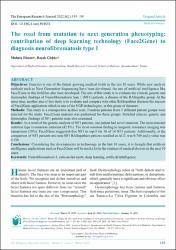| dc.contributor.author | Elmas, Muhsin | |
| dc.contributor.author | Göğüş, Başak | |
| dc.date.accessioned | 2022-06-21T13:32:20Z | |
| dc.date.available | 2022-06-21T13:32:20Z | |
| dc.date.issued | 2022 | en_US |
| dc.identifier.citation | Elmas, M., & Göğüş, B. (2022). The road from mutation to next generation phenotyping: contribution of deep learning technology (Face2Gene) to diagnosis neurofibromatosis type 1. The European Research Journal, 8(2), 145-154. | en_US |
| dc.identifier.issn | 2149-3189 | |
| dc.identifier.uri | https://doi.org/10.18621/eurj.894631 | |
| dc.identifier.uri | https://hdl.handle.net/20.500.12933/1208 | |
| dc.description.abstract | Objectives: Genetics is one of the fastest growing medical fields in the last 10 years. While new analysis methods such as Next Generation Sequencing have been developed, the use of artificial intelligence like Face2Gene in this field has also been developed. The aim of this study is to evaluate the clinical, genetic and dysmorphic findings of Neurofibromatosis type 1 (NF1) patients, a disease of the RASopathy group. At the same time, another aim of this study is to evaluate and compare with other RASopathies diseases the success of Face2Gene application which is one of the NGP technologies, in this group of diseases. Methods: This study is a retrospective archive scan. 14 patients from 3 different patient groups were selected for the study. Face2Gene analysis was performed for these groups. Detailed clinical, genetic and dysmorphic findings of NF1 patients were also examined. Results: As a result of the genetic analysis of NF1 patients, one patient had novel mutation. The most detected mutation type is nonsense mutation (42,8%). The most common finding in magnetic resonance imaging was hamartoma (29%). Face2Gene suggested that NF1 in top-3 for 10 of 14 NF1 patients. Additionally, at the comparison of NF1 patients and non-NF1 RASopathies patients resulted as AUC was 0.749 and p value was 0.134. Conclusion: Considering the developments in technology in the last 10 years, it is thought that artificial intelligence applications such as Face2Gene will be used a lot in the routines of medical doctors in the next 10 years. | en_US |
| dc.language.iso | eng | en_US |
| dc.publisher | PRUSA MEDICAL PUBLISHING | en_US |
| dc.relation.isversionof | 10.18621/eurj.894631 | en_US |
| dc.rights | info:eu-repo/semantics/openAccess | en_US |
| dc.subject | Neurofibromatosis 1 | en_US |
| dc.subject | Cafe-au-lait spots | en_US |
| dc.subject | Deep learning | en_US |
| dc.subject | Artificial intelligence | en_US |
| dc.title | The road from mutation to next generation phenotyping: contribution of deep learning technology (Face2Gene) to diagnosis neurofibromatosis type 1 | en_US |
| dc.type | article | en_US |
| dc.authorid | 0000-0002-5626-2160 | en_US |
| dc.authorid | 0000-0002-5601-8555 | en_US |
| dc.department | AFSÜ, Tıp Fakültesi, Dahili Tıp Bilimleri Bölümü, Tıbbi Genetik Ana Bilim Dalı | en_US |
| dc.contributor.institutionauthor | Elmas, Muhsin | |
| dc.contributor.institutionauthor | Göğüş, Başak | |
| dc.identifier.volume | 8 | en_US |
| dc.identifier.issue | 2 | en_US |
| dc.identifier.startpage | 145 | en_US |
| dc.identifier.endpage | 154 | en_US |
| dc.relation.journal | The European Research Journal | en_US |
| dc.relation.publicationcategory | Makale - Uluslararası Hakemli Dergi - Kurum Öğretim Elemanı | en_US |
















